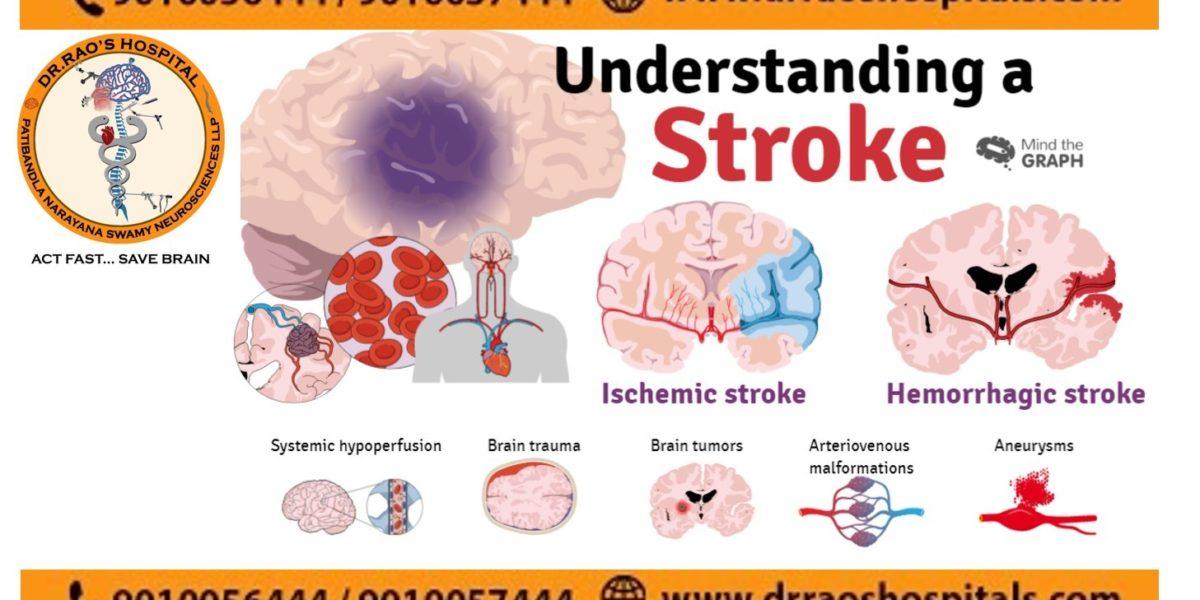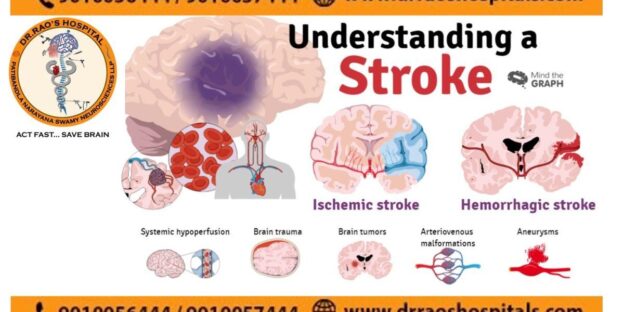The best stroke treatment in Guntur? IV tPA, mechanical thrombectomy
The symptoms of stroke can appear to any person in Guntur at any time. It is a medical emergency that requires immediate attention from the best neurosurgeon in Guntur.
It is nothing but a shortage of oxygen and required nutrition due to disturbed blood supply into your brain. As a result, your brain cells start to die within minutes.
You can prevent brain injury and other problems by getting proper treatment as early as possible.
Sometimes, your blood vessels rupture and lead to bleeding in the brain, both contributing to the stroke. Almost 87% of strokes are due to lack of blood supply, and 13% are due to hemorrhage, i.e., bleeding in the brain.
What are the signs and symptoms?

Best hospital for stroke – Dr Rao’s Hosptial Guntur
When you think you or someone you are with is having a stroke, pay careful attention to when the signs begin. Remember the mnemonic BE FAST, which indicates the symptoms to look for and the need for emergency treatment. Confident treatment choices are highly successful if offered right after the stroke.
Below are the signs and symptoms of a stroke:
You can experience difficulties speaking and understanding what people are doing. You can be confused, slur your sentences, or have trouble interpreting speech.
You may experience numbness or paralysis of the face, arm, or leg. It usually impacts only one side of the body. You can have a stroke if one limb starts to collapse. When you try to smile, one side of your mouth will droop.
You may experience double vision or distorted or blackened vision in one or both eyes. A stroke may also cause symptoms like a severe headache, vomiting, dizziness, or altered consciousness.
You can experience difficulty in walking due to a stroke. You can feel dizziness or a lack of balance as well.
Now, let us see how our neurologist in Guntur makes the diagnosis.
When you arrive at the hospital, we will perform the following tests:
A physical test:
Your doctor will administer a series of checks you are already acquainted with, such as listening to your pulse and blood pressure. We may perform a neurological evaluation to assess the effects of the stroke.
Blood test:
Several blood checks can be done, including one to assess how easily your blood clots, whether your blood pressure is too high or low, and whether or not you have an infection.
CT scan:
A CT scan can also be beneficial in your stroke diagnosis. It produces a clear representation of the brain by using a sequence of X-rays. A CT scan may exclude brain bleeding so we can go ahead with thrombolysis treatment without any delay.
Our neurosurgeon in Guntur Dr. Mohana Rao Patibandla can inject a dye into your bloodstream to allow them to examine the blood vessels in your neck and brain more closely (computerized tomography angiography).
You may require Magnetic resonance imaging:
An MRI creates a precise brain image using strong radio waves and magnets. An MRI can detect brain tissue injury and brain hemorrhages caused by an ischemic stroke.
So, what treatment options are available to you?
If you are having an ischemic stroke or a stroke that causes bleeding through the brain, you will need emergency care. Doctors must rapidly restore blood supply to the brain to cure an ischemic stroke. Our neurosurgeon in Guntur provides the following treatments in case you are suffering from an ischemic stroke.
Ischemic stroke
IV treatment:
In many cases, we can administer intravenous medications that may break up a blood clot in your brain. We administer these medications within 4.5 hours from when the symptoms started and recently up to 9 hours based on the perfusion scanning.
Medications:
It is another significant way of treating stroke. Here, our doctor administers medications directly to the site of the stroke. We use a long, narrow tube through an artery in your groin and thread it to your brain, called IA thrombolysis, which may be needed in some small vessel disease cases.
Endovascular surgeries:
Ischemic strokes are often treated immediately inside the blocked blood vessel by our Dr. Mohana Rao Patibandla, the interventional neurosurgeon or endovascular neurosurgeon, with the help of a suction device or with the help of a stentreiver if the patient is here within 24 hours.
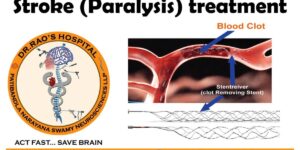
Minimally Invasive Approaches for Treating Brain Stroke: Advancements at Dr. Rao’s Hospital – Mechanical Thrombectomy and IV tPA
After an ischemic stroke, endovascular treatment can increase outcomes and minimize long-term disability in up to 70% of patients after proper selection through perfusion imaging. Our interventional team, led by Dr. Mohana Rao Patibandla, is the best in Guntur, Andhra Pradesh, and India.
A stent retriever:
As one of the best neurosurgeons in Guntur, our doctor will clear the clot from the damaged blood artery in your brain using a system connected to a catheter. This method benefits people with big clots that medicines cannot remove entirely.
Hemorrhagic stroke:
Controlling the bleeding and reducing the pain in your brain caused by the extra blood are the main goals of emergency care for hemorrhagic stroke. There are multiple recovery services available, including:
Treatment in an emergency:
When you use blood thinners to avoid blood clots, we might provide medications or blood transfusions to mitigate the effects of blood thinners. We can give prescription medications to reduce intracranial pain, blood pressure, blood vessel spasm reduction, and seizure prevention.
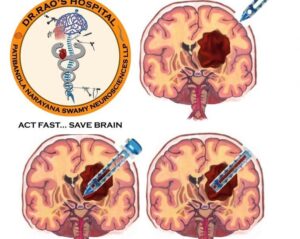
the-best-intracranial-hemorrhage-treatment-at-dr-Rao’s with brain path using neuronavigation and CUSA
Surgical procedures: Our doctor can perform surgery to remove the blood and relieve pressure on your brain if the bleeding is high.
Clipping by a surgeon: To stop the aneurysm’s blood supply, the best neurosurgeon in Guntur can put a tiny clip at its root. This clip will prevent an aneurysm from bursting or from bleeding again after it has already bled.
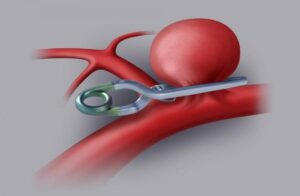
Dr. Rao performs aneurysm clipping surgery at Dr. Rao’s Hospital, focusing intently on advanced medical equipment in the background.
Coiling (endovascular embolization): Your surgeon can put tiny detachable coils into the aneurysm. He can use a catheter implanted into an artery in your groin and directed to your brain. It helps in blocking the blood supply into the aneurysm and causes clots.
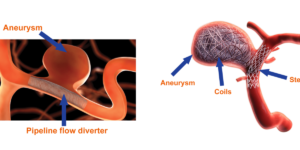
Brain aneurysm treatment at Dr Rao’s Coiling and Flow Diverter

